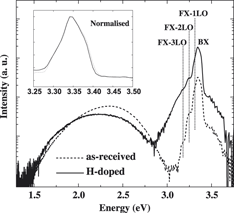Crossref Citations
This article has been cited by the following publications. This list is generated based on data provided by
Crossref.
Sarkar, A
Chakrabarti, Mahuya
Bhowmick, D
Chakrabarti, A
Ray, S K
Rafaja, D
and
Sanyal, D
2013.
Defects in 6 MeV H+irradiated hydrothermal ZnO single crystal.
Journal of Physics: Condensed Matter,
Vol. 25,
Issue. 38,
p.
385501.
Lem, Laurent L.C.
Phillips, Matthew R.
and
Ton-That, Cuong
2014.
Controlling the visible luminescence in hydrothermal ZnO.
Journal of Luminescence,
Vol. 154,
Issue. ,
p.
387.
Ton-That, C
Lem, L L C
Phillips, M R
Reisdorffer, F
Mevellec, J
Nguyen, T-P
Nenstiel, C
and
Hoffmann, A
2014.
Shallow carrier traps in hydrothermal ZnO crystals.
New Journal of Physics,
Vol. 16,
Issue. 8,
p.
083040.
Shimizu, H.
Sato, W.
Mihara, M.
Fujisawa, T.
Fukuda, M.
and
Matsuta, K.
2018.
Temperature-dependent thermal behavior of impurity hydrogen trapped in vacancy-type defects in single crystal ZnO.
Applied Radiation and Isotopes,
Vol. 140,
Issue. ,
p.
224.
Suresh, Sreya
Urs, Kusuma M. B.
Vasudevan, Anupama T.
Sriram, Sharath
and
Kamble, Vinayak B.
2019.
Analysis of Unusual and Instantaneous Overshoot of Response Transients in Gas Sensors.
physica status solidi (RRL) – Rapid Research Letters,
Vol. 13,
Issue. 6,
Manyam, Jedsada
Ton-That, Cuong
and
Phillips, Matthew R.
2020.
Cathodoluminescence study of electric field induced migration of defects in single crystal m-plane ZnO.
Journal of Applied Physics,
Vol. 127,
Issue. 8,
Li, Qianli
Hu, Yahua
Zhang, Min
Gui, Zhao
Zhang, Zhijun
Zhao, Jingtai
Zhu, Liguo
Cheng, Xiao
and
Ma, Daiming
2021.
Hydrothermal synthesis and characterization of ZnO nanowire arrays within anodic aluminum oxide template.
p.
28.
Elrahoumi, Raja
Zhu, Liangchen
Wagner, Estelle
Maudez, William
Benvenuti, Giacomo
Phillips, Matthew R.
and
Ton-That, Cuong
2023.
Doping-induced Ti3+ state and oxygen vacancies in TiO2: A single-chip combinatorial investigation.
Materials Chemistry and Physics,
Vol. 308,
Issue. ,
p.
128283.
Wang, Li-Wen
and
Chu, Sheng-Yuan
2023.
Effects of Post-Annealing on the Properties of ZnO:Ga Films with High Transparency (94%) and Low Sheet Resistance (29 Ω/square).
Materials,
Vol. 16,
Issue. 19,
p.
6463.
Hossein-Babaei, Faramarz
and
Alizadeh, Armin
2024.
Sputter deposition of hydrogen-doped ZnO layers under humid oxygen plasma.
Journal of Materials Science: Materials in Electronics,
Vol. 35,
Issue. 20,
